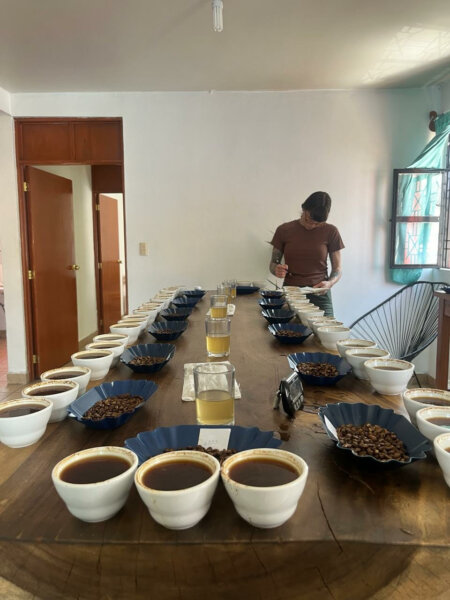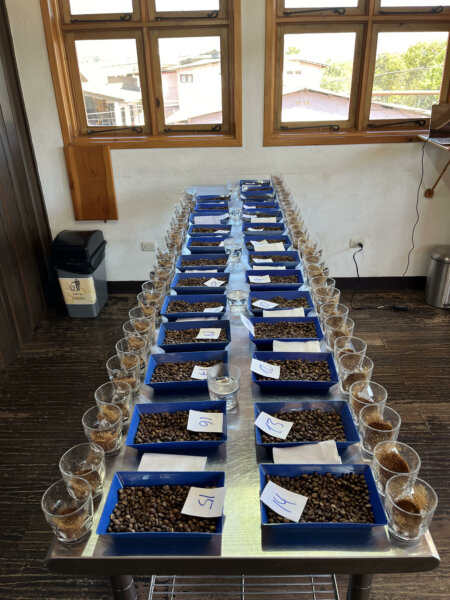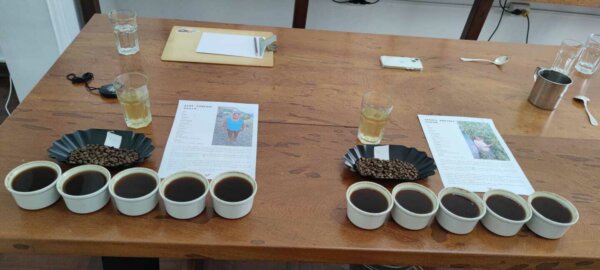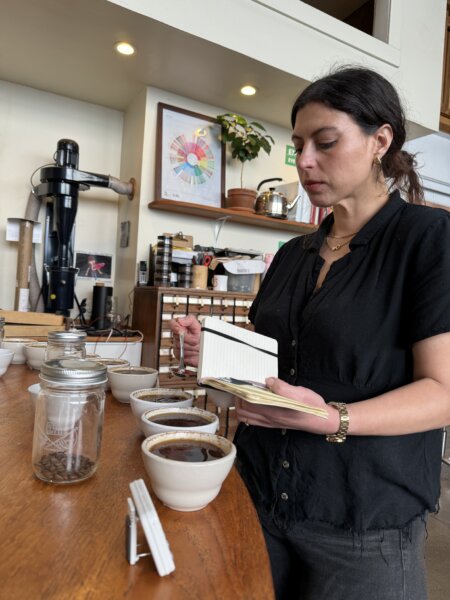Cupping, a simple and standardized tasting method used for assessing the raw quality of coffee, varies hugely between a home lab or roastery setting and origin. There are great reasons to go to origin to cup, both for roasters and for us at Red Fox. In this piece, we explore when it might be better to go to origin to cup, when it might be best to stay home, and the differences between the two. We also delve into factors to beware of when cupping at origin, tips on staying focused and avoiding palate fatigue, and the simple human value of being home versus being abroad.
Why go to origin?

Some of the best reasons to go to origin are:
- Connecting with the land and people who grow your coffee
- Gaining a firsthand understanding of how coffee gets from a tree to the roastery
- Developing a better dialog with and understanding of your importers
- Getting first crack at offers
- Being able to collect your own marketing material
Firsthand Insight: Gaining Context & Building Relationships
We all see pictures and videos of coffee on trees, coffee being harvested, coffee being processed. But, seeing those things in real life and meeting or connecting with the people who do that labor can be very enriching and bring an actualized understanding that fosters better communication with producers, importers and other origin partners.
“Working with importing and exporting partners, it’s so helpful for me to cup with the people choosing coffees in country,” says Daria Whalen of Ritual Coffee. “I learn so much by hearing what they are looking for in either blending a community lot or separating micro lots. It’s not only beneficial for establishing calibration and trust, but also for learning. It expands my perspective and my palate.”
When roasters cup in the lab, they’re attuned to a very specific process, environment, and group of people. Getting outside that box to cup with new people from different cultural contexts is helpful for understanding the different ways our subcultures inform our tastes and tasting notes.
“Roasters can gain a ton of insight as to how insular their cupping experience is,” says Drew Fitchette of Red Fox. “At origin you’re often interacting with coffee people whose background is incredibly different from your own. It’s nice to take the blinders off every once in a while.”
As green importers, one of the best reasons to be on site is relationship building. We learn so much from personal interactions and gain trust with suppliers through time spent. We get some of our best coffees due to the time we devote to being there and learning through asking questions and better understanding our partners.
Early Access: Behind the Velvet Rope
Tasting coffee at origin allows both importers and roasters to get early access to the coffees we want—we can taste something we love and commit on the spot, guaranteeing our access. This is crucial to our sourcing strategy at Red Fox, and it’s a process we love to share with roaster partners.
Photos, Videos, Stories, & Consent
At Red Fox, we do our best to gather photos, videos, and stories varied enough to meet the needs of all our roaster partners. But, there’s nothing like being the one behind the camera. When you go to producing countries, you can gather your own marketing material to your exact specifications, including aspects like photo consent.
Why stay home?

The best reasons to stay home instead of going to origin are:
- Cost of travel
- Ability to cup in a controlled environment with minimal variables and distractions
Financial & Environmental: The Costs of Travel
While travel is enriching and can even be essential, it’s not cheap. The cost of plane tickets, transit in-country, lodgings, and more all gets tacked onto the final cost of the coffee you end up purchasing. Sometimes it’s more than worth it, but sometimes it makes more sense to cup and make decisions from home.
“If you’re traveling to origin to buy a fairly small quantity of coffee, you’re going to be adding to the price per pound of the coffee to pay for the trip,” says Joel Edwards of Red Fox. “There’s a lot of benefit, but the cost gets weighed against that.”
Another cost to factor in is environmental impact. Air travel is carbon-intensive. As climate change hits the countries in which coffee grows, shaking up once-predictable weather patterns, a lot of roaster partners have begun to consider this aspect as part of the cost of their travel—whether that means literally buying carbon offsets or just thinking twice before booking that plane ticket.
Controlled Environments: Roast, Grind-Size, Comfort, & Sleep
In your regular workplace, you benefit from controlled variables that make it easy to make sound decisions. From actual cupping variables like sample roast level to grind size to brew water to the ability to sleep in your own bed and manage your hydration levels, the smallest factors can affect your palate and decisions. When we travel, we sacrifice this guarantee of consistency.
“ At home we have cupping labs, we have great water, we have our own beds at night,” says Dakota Graff of Onyx Coffee Labs. “Being well-rested and cupping is objectively easier than being jet-lagged. But all that said, traveling is still very worth it.”
How should I approach cupping at origin?

Cupping at origin requires some physical preparation, but also mental awareness of the different environment you’re inhabiting and how that might affect your experience.
Drink Water, Sleep, & Eat
When cupping at origin, try to get as much sleep as you can, drink more water than you think you need to account for elevation, make sure you have snacks, and don’t be afraid to ask for a spit cup to avoid overcaffeination.
Don’t Overcup, Do Take Notes
One way to stay focused and make good decisions is to limit cupping to the essential.
“Try to limit the number of samples in order to maintain sensitivity and schedule short breaks between sessions to prevent sensory overload,” says Ashley Box of Amaya Coffee. If you can’t limit the amount you need to cup, try to schedule more time, like 2 days instead of just 1.
Carina Barreda of the Red Fox team recommends looking for the specific attributes you need for your coffee program, rather than concentrating on all the various aspects you can assess.
Drew recommends waiting for coffees to cool fully so you can taste their full contents on first pass. Then, hit everything once and make note of things you know aren’t what you’re looking for. “The coffees will find a good home,” he says. “There’s no need for you to cup them again if they don’t meet your quality threshold.”
“Set up systems to take notes and log data,” says Dakota. “I use Cropster, but any system that allows you to note and share scores, detailed feedback, and whether you’re purchasing the coffee will up your efficiency.”
Countering Environmental Differences & Bias
In order to calibrate to the different setting in which you’re cupping, Drew advises bringing a coffee you know really well so you can calibrate to how it tastes different on different equipment.
“Your biases follow you everywhere,” says Daria. “For example, I have a bias against the first cup on the table. On the flip side, if I really believe in what a company or producer is doing, maybe I’ll be biased to score it a point higher because of that relationship—so I do have to look out for that.” She tries to mitigate this by planning heavily and keeping in tight communication with colleagues back home.
It’s also important to remember to be a conscientious guest. Cupping coffees at origin takes time, energy, and resources from the people you’re visiting. “Be kind to them, offer to help clean up, thank them for their time, and don’t lead them to believe you’re going to buy coffee if you’re not,” says Drew.
Value comes in many forms

Cupping at origin may present a whole slate of challenges, but it also presents a whole realm of opportunities for growth and connection.
When assessing the added fiscal and environmental costs of travel, also think of the richness of added interaction and spontaneity that visiting origin partners brings. When approaching the difficulties of managing variables outside of your own cupping lab, weigh them against the benefit of getting outside your silo and expanding your perspective by cupping with those who produce and move your coffee. When thinking of how biases might hinder your decision making at origin, balance that against the potential for overcoming biases you might not even be aware you’re holding by getting outside your own circle.
Interested in sourcing coffee with us? Reach out at info@redfoxcoffeemerchants.com. To learn more about our work, check out our journal and follow us on Instagram @redfoxcoffeemerchants, Twitter @redfoxcoffee, Spotify, and YouTube.
